Understanding the Need for De-escalation in Memory Care Units
Memory care units present unique challenges when managing conflict due to residents often experiencing cognitive impairments such as dementia. These conditions can lead to heightened agitation, confusion, and behavioral disturbances that require specialized de-escalation techniques. Equipping staff with the right skills and knowledge is essential not only to ensure resident safety but also to promote a compassionate environment that supports both mental health and holistic care.
Comprehensive Treatment Services for Addiction and Substance Abuse in Behavioral Care Settings

What types of treatment services are available for substance abuse and addiction?
Treatment for substance abuse and addiction encompasses various evidence-based approaches tailored to individual needs. Key services include:
- Detoxification: Medically supervised withdrawal management to safely handle physical dependence.
- Counseling and Behavioral Therapies: Techniques such as cognitive behavioral therapy (CBT) and motivational interviewing (MI) help patients understand and change addictive behaviors.
- Medications: Approved drugs like methadone, buprenorphine, naltrexone, and acamprosate are used to reduce cravings and prevent relapse.
How is treatment integrated at medical centers?
Many local Veterans Affairs (VA) medical centers provide comprehensive addiction care. They offer assessments, inpatient or residential rehabilitation programs, and referrals to specialized services. This integrated approach facilitates coordination between medical and behavioral health practitioners, ensuring holistic patient care.
What support systems aid in sustained recovery?
Long-term recovery is supported through aftercare programs that might include ongoing therapy, medication management, and case management. Mutual support groups like Alcoholics Anonymous (AA) provide peer support and shared experiences. Additional resources such as crisis helplines and family support services play vital roles in maintaining recovery and preventing relapse.
These multifaceted treatment and support options address both physical withdrawal and psychological aspects, fostering sustainable recovery in behavioral care settings.
Addressing Mental Health Alongside Addiction Treatment in Memory Care
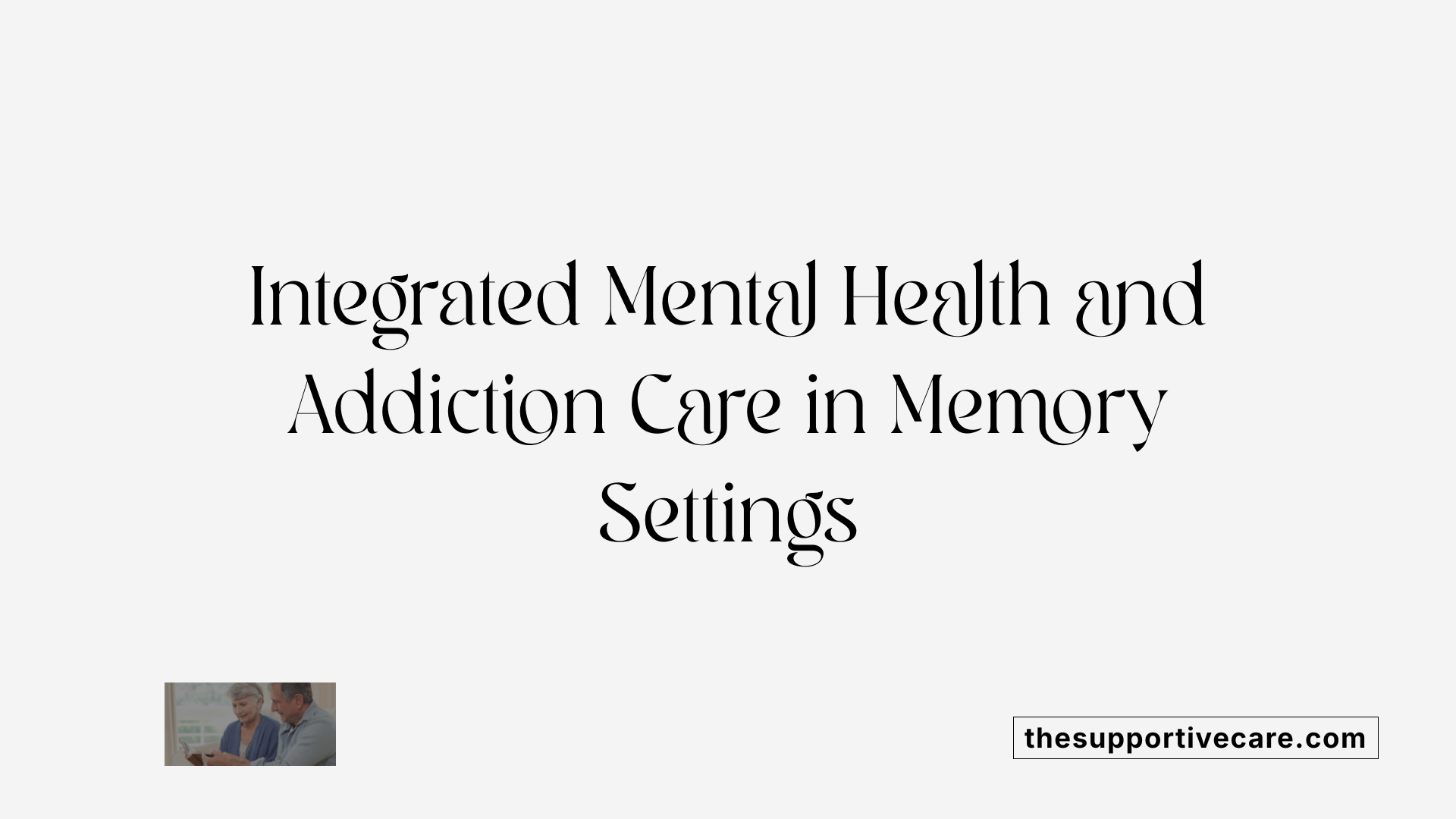
How are mental health issues addressed alongside addiction treatment?
In memory care settings, addressing mental health issues alongside addiction treatment requires an integrated approach that targets both conditions simultaneously. This often involves coordinated services by trained healthcare professionals adept in managing co-occurring disorders.
Integrated treatment approaches for co-occurring mental health and addiction
Integrated treatment combines mental health care and addiction services within the same care plan, facilitating better communication among providers and more efficient, personalized interventions. This approach recognizes that conditions such as depression, anxiety, and PTSD often coexist with substance use disorders, influencing symptoms and treatment outcomes.
Screening tools for early detection
Effective integrated care depends on early identification. Tools like the Alcohol Use Disorders Identification Test (AUDIT) and the Patient Health Questionnaire-9 (PHQ-9) are commonly used to screen for substance use and depressive symptoms, respectively. These tools help clinicians detect issues early, enabling timely and targeted treatment.
Behavioral therapies and medication management
Behavioral therapies such as motivational enhancement therapy, cognitive-behavioral therapy (CBT), and relapse prevention strategies are cornerstone treatments. Medication management is also critical, with pharmacologic interventions tailored to address both addiction and mental health symptoms while considering the cognitive vulnerabilities common in memory care residents.
Family and peer support integration
Family involvement and peer support play vital roles in recovery by creating a supportive environment and reinforcing treatment goals. Incorporating these supports improves engagement, reduces feelings of isolation, and enhances recovery outcomes.
Overall, integrated mental health and addiction treatment in memory care results in better clinical outcomes, fewer hospitalizations, and improved quality of life for residents facing these complex challenges.
Range of Addictions Managed Through Comprehensive Treatment Services

What forms of addiction can comprehensive treatment services address?
Comprehensive treatment services tackle a broad spectrum of addiction types, encompassing both substance and behavioral addictions. Substance addictions frequently managed include alcohol, opioids, stimulants, and other drugs. In addition, these services address behavioral addictions such as gambling, internet use, gaming, and compulsive eating, which often stem from psychological and emotional factors.
Types of Addictions Addressed
- Substance Addictions: Alcohol, opioids, stimulants, prescription medications, and illicit drugs.
- Behavioral Addictions: Gambling disorder, internet addiction, gaming disorder, compulsive eating.
Levels of Care and Treatment Modalities
Comprehensive services offer multiple levels of care adapted to individual needs and addiction severity. These include:
- Outpatient Programs: Flexible care allowing patients to live at home while receiving therapy and counseling.
- Intensive Outpatient Programs (IOP): Structured treatment several days a week for individuals requiring more support.
- Inpatient and Residential Programs: 24/7 care in a controlled environment for severe addiction cases.
Treatment modalities integrate various approaches, such as individual therapy, group counseling, medication-assisted treatment (MAT), and peer support networks. These are designed to address the addiction while supporting recovery and relapse prevention.
Importance of Addressing Underlying Mental Health Issues
Treatment services understand addiction as a complex chronic condition often intertwined with mental health disorders like depression, anxiety, trauma, or PTSD. Addressing underlying psychological issues is critical for effective recovery. Integrated care models provide simultaneous treatment of co-occurring disorders, enhancing outcomes and empowering individuals to manage both addiction and associated mental health challenges.
| Addiction Type | Examples | Treatment Approach |
|---|---|---|
| Substance Addictions | Alcohol, opioids, stimulants | Medication-assisted treatment, therapy, relapse prevention |
| Behavioral Addictions | Gambling, gaming, internet usage | Cognitive-behavioral therapy, support groups, counseling |
| Levels of Care | Outpatient, IOP, inpatient, residential | Tailored intensity of treatment depending on severity |
| Integrated Treatment | Co-occurring mental health disorders | Combined addiction and mental health therapies |
Foundations of Behavioral Health Training in Memory Care Units

Why Is Behavioral Health Training Important for Nursing Facility Staff?
Behavioral health training is essential for nursing facility staff, especially in memory care units, where residents often exhibit complex behavioral needs. This training equips staff with the necessary skills to manage these behaviors safely and effectively, reducing risks of conflict and improving overall safety.
What Skills Help Manage Complex Behaviors?
Staff learn to understand behavioral patterns and recognize early warning signs that indicate potential escalation. Training emphasizes the use of empathy, calm communication, and an appreciation of the resident’s history and trauma, which lead to more tailored and successful interventions.
How Does Training Prevent Conflict Escalation?
The training focuses on proactive strategies such as nonverbal communication cues, acknowledging resident feelings, and creating a calm environment. These approaches help de-escalate situations before they intensify, thereby preventing physical or emotional harm.
How Does Empathy Enhance Safety Within Nursing Facilities?
Empathy fosters trust and understanding between staff and residents. By genuinely considering residents’ feelings and needs, staff can respond with reassurance and clear communication, promoting a safer and more supportive care atmosphere.
Recognizing Early Warning Signs to Prevent Conflict Escalation
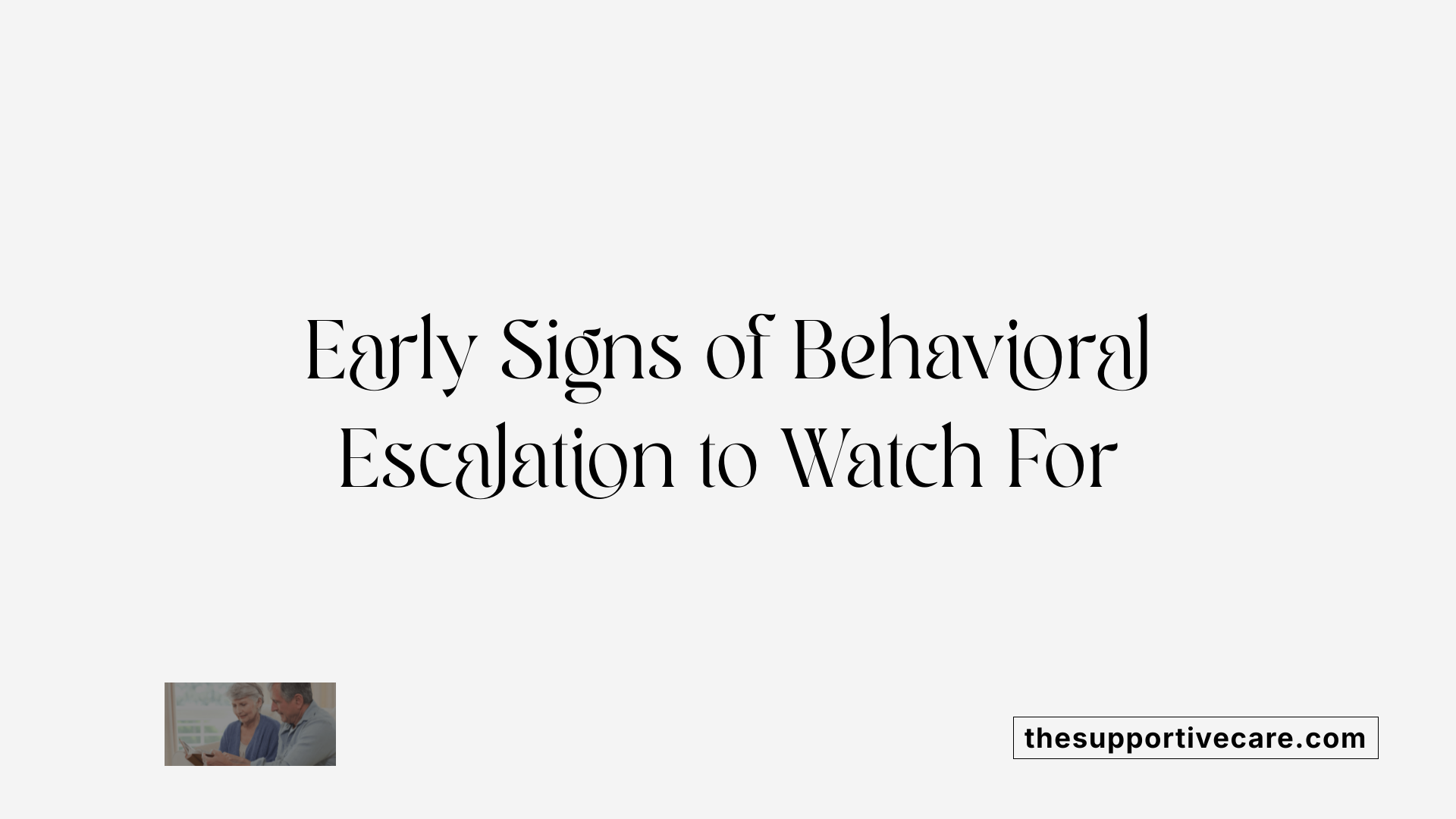
What Are Early Warning Signs of Behavioral Escalation?
Early warning signs are subtle behavioral cues that indicate a potential rise in agitation or aggression. These include changes in tone of voice, such as increased volume or sharpness, and shifts in body language like clenched fists, pacing, or withdrawal. Recognizing these signs early enables staff to respond before the situation intensifies.
How Do Behavioral Patterns Signal Escalation?
Behavioral patterns such as repeated requests, irritability, or sudden mood swings often precede aggressive behaviors. Staff trained to observe these patterns can anticipate difficulties and intervene proactively. For example, a resident showing increased restlessness or frustration may benefit from immediate calming techniques.
Why Is Proactive Awareness Crucial?
Proactive awareness involves continuous monitoring of emotional and environmental factors that could trigger escalation. It requires staff to be attuned to their internal responses, residents’ histories, and situational contexts. This mindfulness helps prevent incidents by addressing triggers early and applying tailored de-escalation strategies.
How Does Early Recognition Impact Prevention of Violence or Harm?
Timely identification of escalation signs allows for swift intervention, reducing the likelihood of physical violence or injury. It fosters a safer environment for both residents and staff by promoting de-escalation through calm communication, reassurance, and environment adjustments. Ultimately, it supports a culture of safety and empathy within the nursing facility setting.
Mastering Nonverbal Communication and Personal Readiness for De-escalation
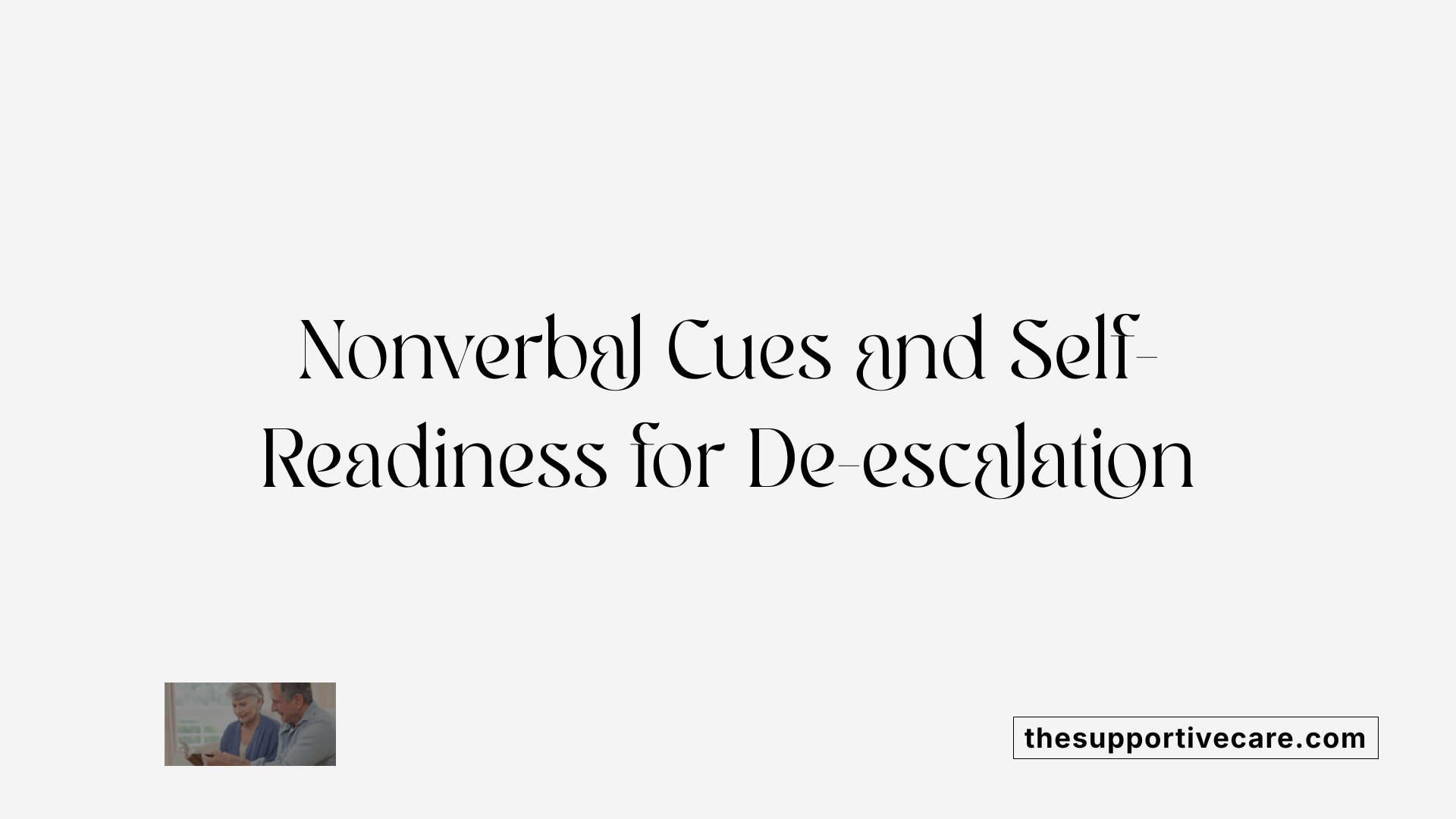
The role of nonverbal cues in de-escalation
Nonverbal communication is crucial in managing tense situations in nursing facilities. It often speaks louder than words and can either calm or inflame a resident's agitation. Staff trained in behavioral health learn to observe and use nonverbal cues thoughtfully to promote safety and understanding.
Maintaining eye contact and open posture
Maintaining gentle eye contact is a key nonverbal technique that shows attentiveness without being confrontational. An open posture—keeping arms relaxed and body orientation neutral—signals approachability and respect. These cues help build trust and prevent escalation by showing the resident they are being heard and respected.
Calm movements and voice tone
Moving slowly and deliberately, while avoiding sudden or exaggerated gestures, reduces the risk of alarming residents. Similarly, speaking in a calm, clear, and neutral tone helps soothe emotions rather than provoke them. This controlled approach supports conflict de-escalation by lowering the emotional temperature of the interaction.
Provider self-awareness and emotional regulation
Effective de-escalation begins with the provider's own attitudes and self-control. Emotional self-regulation techniques like mindful breathing and pausing before responding empower staff to stay calm under pressure. Self-awareness allows providers to recognize their internal triggers, ensuring they do not unintentionally escalate behavior. This personal readiness is essential for fostering a safe environment where challenging behaviors can be managed constructively.
Effective Verbal De-escalation Techniques in Memory Care
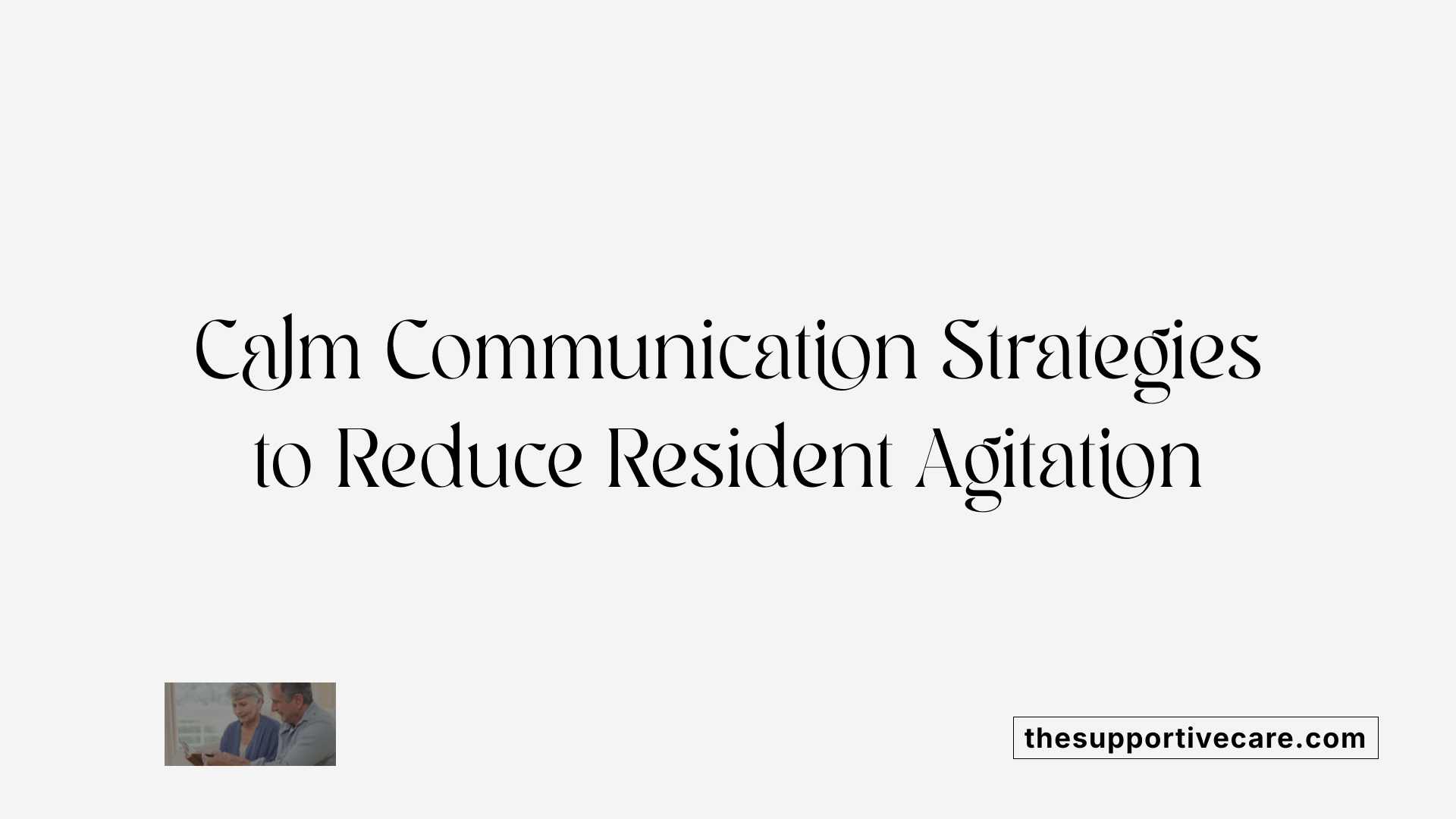
Using Calm and Clear Language
In memory care, employing calm and clear language is essential to reduce agitation and confusion. Speaking slowly and simply helps residents with cognitive impairments grasp the message without feeling overwhelmed. Calm speech tones soothe emotions and prevent further escalation.
Acknowledging Residents' Feelings
Recognizing and verbalizing residents’ emotions builds trust and validates their experience. Statements like “I see you’re upset” or “It sounds like you’re feeling frustrated” show empathy, which helps de-escalate tension and fosters a supportive environment.
Offering Choices and Reassurance
Providing residents with manageable choices—such as "Would you like to sit here or over there?"—helps restore a sense of control often diminished in memory care. Coupled with reassurance, these tactics reduce anxiety and empower residents.
Maintaining a Neutral and Respectful Tone
Using a neutral, respectful tone without judgment or irritation conveys safety and respect. This non-threatening verbal approach encourages cooperation and diffuses aggressive or defensive behaviors.
Summary Table:
| Technique | Description | Purpose |
|---|---|---|
| Calm and Clear Language | Slow, simple speech with a soothing tone | Reduces confusion and agitation |
| Acknowledging Feelings | Verbal recognition of emotions | Builds empathy and trust |
| Offering Choices and Reassurance | Providing manageable options and emotional support | Restores control and reduces anxiety |
| Neutral and Respectful Tone | Non-judgmental, calm vocal delivery | Encourages cooperation and safety |
Understanding Behavioral Triggers and Tailoring Interventions
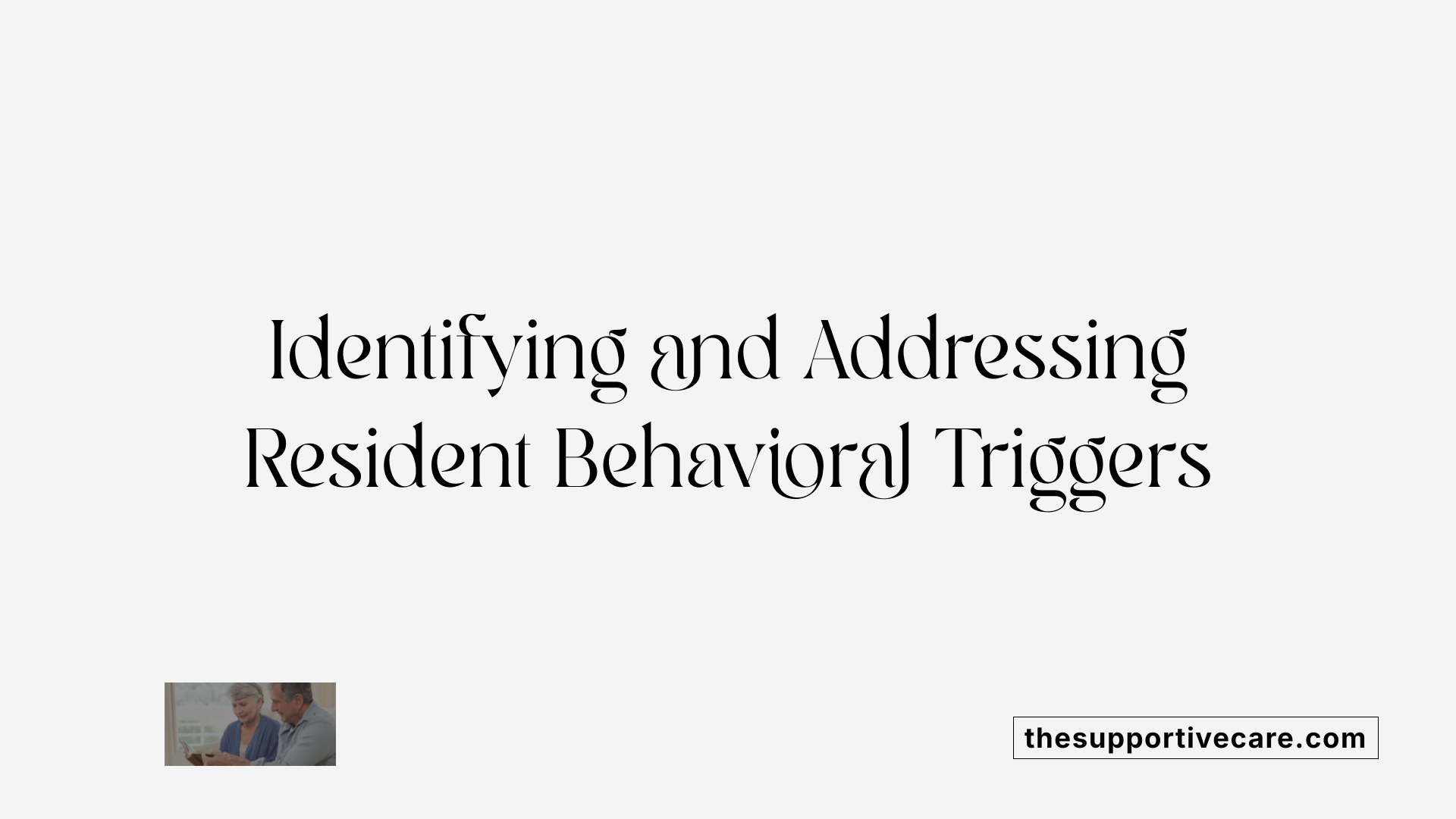
What are common behavioral triggers like fear, manipulation, and frustration?
Behavioral triggers in nursing facilities often include fear, manipulation, and frustration. These triggers stem from residents' underlying emotions and needs. For example, fear might arise from feelings of vulnerability or confusion, manipulation can be a way to seek control or attention, and frustration usually stems from unmet needs or communication barriers.
Why is it important to understand the causes of these behaviors?
Understanding the root causes behind resident behaviors is crucial for effective intervention. Many behaviors are attempts to communicate thoughts, feelings, or needs, especially in individuals with cognitive impairments such as dementia or traumatic brain injury. Recognizing these causes helps staff respond with empathy and avoids escalating tensions.
How can specific intervention techniques be applied?
Intervention techniques are tailored based on the identified triggers and resident history. For instance, acknowledging a resident’s feelings through calm reassurance can reduce fear. Using clear and non-threatening body language helps when dealing with manipulation or frustration. Training often includes role-playing scenarios to practice these skills.
How do these interventions promote safety and reduce escalation?
By applying appropriate techniques, staff can prevent behaviors from escalating into aggressive or unsafe situations. Proactively recognizing early warning signs and responding calmly maintains a safe environment for both residents and staff. Emphasizing empathy, respect for cultural and individual differences, and active listening fosters trust and de-escalates potential conflicts before they intensify.
The Role of Trauma History and Cultural Sensitivity in Conflict Management
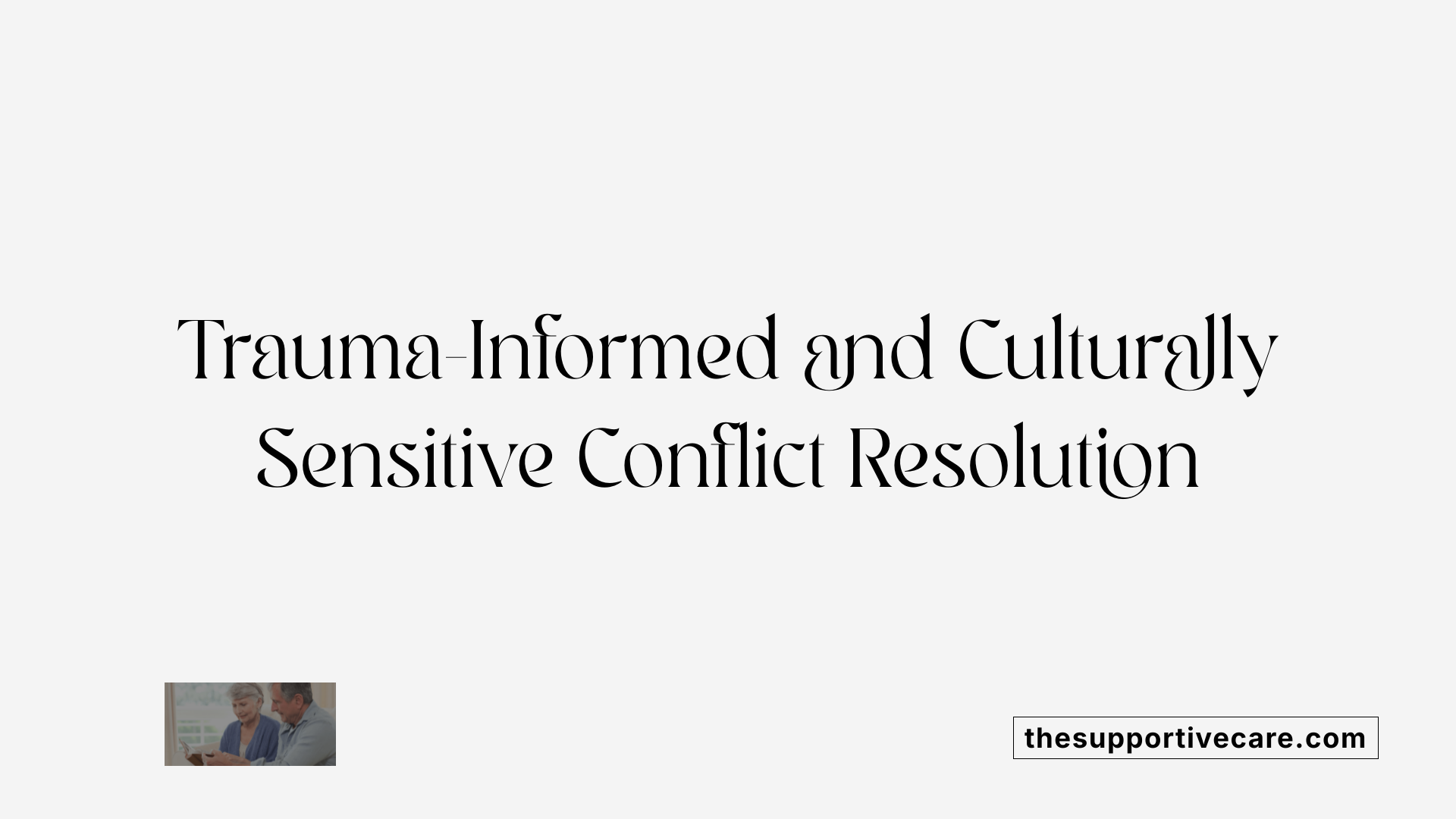
Why is knowledge about a resident's trauma history important?
Understanding a resident's trauma history is fundamental in behavioral health training for nursing facilities. Trauma can significantly influence how residents respond to stress or perceived threats, often manifesting in crisis behaviors. Recognizing these patterns allows staff to approach care with empathy, tailoring interventions to the resident's unique experiences and reducing the risk of escalation.
How do cultural and gender differences impact conflict management?
Cultural background and gender identity shape communication styles, perceptions of care, and behavioral responses. Being aware of these differences enables nursing staff to avoid misunderstandings and inadvertent disrespect that might trigger distress or aggression. Sensitivity to these aspects ensures that responses are respectful and appropriate, promoting a safer environment for both residents and staff.
What role does respectful communication play in de-escalation?
Respectful communication involves actively listening, acknowledging feelings, and using clear, calm language while honoring cultural and individual preferences. This approach fosters trust and validates the resident's experience, which can defuse tensions and prevent escalation. Nonverbal cues aligned with respectful communication, such as open posture and steady eye contact, further support these efforts.
How does trauma-informed and culturally aware care enhance intervention effectiveness?
When staff integrate knowledge of trauma history and cultural context, interventions become more personalized and responsive. Understanding the causes behind behaviors—such as trauma triggers or cultural misunderstandings—allows for targeted strategies that address root needs rather than just symptoms. This leads to more successful de-escalation, increased safety, and improved overall wellbeing for residents.
| Aspect | Description | Impact on Conflict Management |
|---|---|---|
| Trauma Awareness | Recognizing personal history influencing behavior | Enables empathy-driven, tailored responses |
| Cultural Sensitivity | Understanding cultural/gender differences | Prevents miscommunication and promotes respect |
| Respectful Communication | Using clear, calm, and validating language | Builds trust and reduces tension |
| Personalized Intervention | Tailoring techniques based on trauma and culture | Enhances effectiveness and safety |
Creating a Calm Environment to Facilitate De-escalation
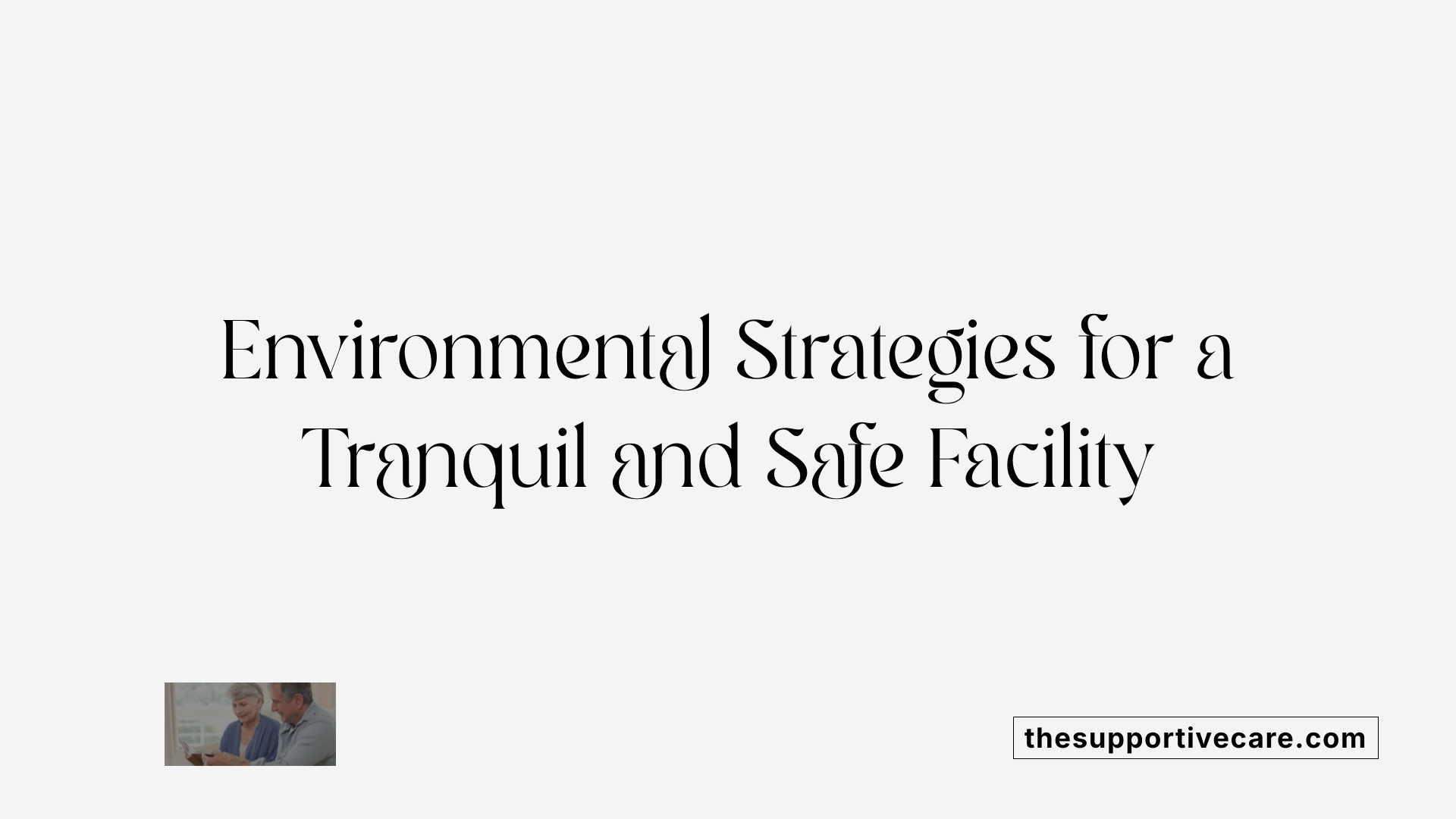
What environmental modifications help reduce agitation?
Creating a calm environment begins with adjusting the physical space to minimize triggers that can escalate behaviors. Nursing facilities can use soft lighting, muted colors, and comfortable furniture to promote relaxation. Reducing noise levels by limiting loud alarms and background noises also helps in lowering stimulation that could cause distress.
How can reducing stimuli prevent agitation?
Overstimulation often leads to increased anxiety or agitation. To prevent this, it’s important to eliminate unnecessary clutter and provide quiet zones where residents can retreat. Limiting interruptions during activities and offering familiar objects can bring comfort and reduce behavioral escalations.
Why is safety readiness important in these settings?
Safety readiness ensures both staff and residents remain protected during potential crisis behaviors. Being prepared means recognizing the presence of possible hazards, such as sharp objects or unsecured areas, and having clear protocols that allow for quick, calm intervention. Maintaining safety reassures residents and staff, aiding in a peaceful atmosphere.
What strategies support maintaining a peaceful atmosphere?
Staff can use calm, slow movements and maintain non-threatening body language to foster tranquility. Consistent routines help residents feel secure, and staff trained in emotional self-regulation can model calmness. Furthermore, providing choices to residents respects their autonomy, decreasing frustration. Regular breaks for staff and residents also help sustain this peaceful environment.
Together, these environmental changes and safety measures lay the groundwork for effective de-escalation by reducing triggers and promoting a sense of security throughout nursing facilities.
Post-Incident Debriefing and Continuous Staff Education

Learning from Conflict Incidents
After any behavioral incident in nursing facilities, it is crucial to conduct a thorough review to identify what occurred and how staff responded. This process enables the team to learn from real situations, understanding both successes and areas needing improvement. Emphasizing learning helps prevent repeat incidents and tailors future interventions for better outcomes.
Importance of Regular Training
Continuous education through structured training is vital to keep nursing staff prepared for managing escalating behaviors. Regular sessions reinforce knowledge about behavioral patterns, nonverbal cues, and de-escalation techniques. This ongoing learning approach ensures skills remain sharp and adapts to new challenges or resident needs.
Role of Debriefing Sessions
Debriefing brings together involved staff to discuss an incident calmly and constructively. It provides a safe environment to express feelings, clarify misunderstandings, and review appropriate responses. These meetings foster collective responsibility and promote shared strategies that support effective de-escalation.
Building a Culture of Empathy and Understanding
Through continuous training and debriefings, nursing facilities cultivate an environment where empathy and respect are central. Staff become more attuned to recognizing residents’ needs and early warning signs of distress. This culture encourages proactive and compassionate interventions, ultimately enhancing safety and well-being for both residents and caregivers.
Simulation-Based Training for Skill Reinforcement
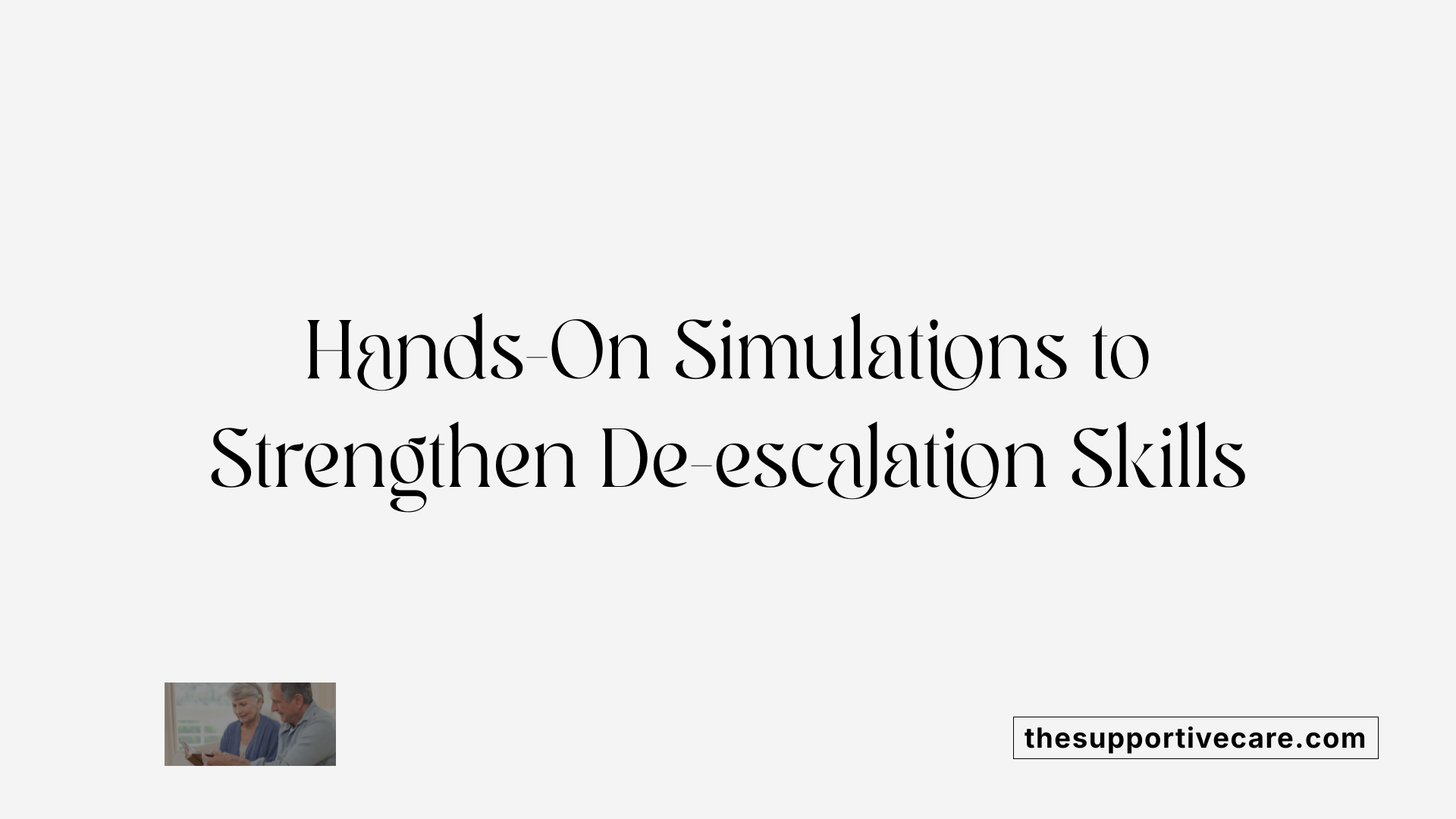
Role-Playing and Scenario Practice
Simulation-based training in nursing facilities often incorporates role-playing and scenario-based exercises. These practical approaches allow staff to actively engage in realistic situations involving aggressive or agitated residents. By stepping into these roles, staff can practice de-escalation strategies in a controlled environment, enhancing their ability to respond calmly and effectively during actual incidents.
Building Staff Confidence
Through repeated simulation exercises, nursing staff gain valuable experience that boosts their confidence in managing complex behavioral challenges. This hands-on learning helps reduce anxiety when dealing with escalating behaviors, enabling caregivers to apply techniques such as empathy, calm verbal communication, and safety awareness with greater assurance.
Online and In-Person Training Formats
Training programs offer flexible delivery with both online modules and in-person sessions. Online materials provide foundational knowledge, including behavioral health concepts and early warning signs, often complemented by knowledge checks to reinforce understanding. In-person sessions focus heavily on interactive components like role-play and group discussions, encouraging collaboration and peer learning.
Knowledge Checks and Discussions
Embedded knowledge checks in online courses assess comprehension of key de-escalation principles, while facilitated discussions during in-person training allow staff to share experiences and clarify complex scenarios. These components together ensure that staff not only learn theoretical content but also translate it into practical skills.
By combining online education with hands-on simulations and critical reflection, nursing facilities can effectively prepare their teams to handle conflict situations with greater skill, empathy, and safety.
Safety Preparedness: Handling Aggressive or Agitated Residents

What does preparedness for potential hazards involve?
Preparedness in nursing facilities demands that staff anticipate and manage safety risks linked to aggressive or agitated behaviors. This includes training staff to remain alert to environmental and behavioral cues that precede escalation. Being ready involves continuous education about possible triggers, ensuring the environment minimizes hazards, and having clear procedures for responding swiftly and effectively.
How can staff recognize the presence of weapons?
Staff are trained to observe subtle and overt signs indicating the presence of weapons or objects that could be used as weapons. Recognizing such risks early is critical for preventing violence. Training emphasizes vigilant observation of residents’ belongings, body language, and unusual movements, coupled with respectful engagement to uncover potential threats without escalating tension.
How is safety maintained for both staff and residents?
Maintaining safety requires creating a calm, controlled environment supported by proactive communication and de-escalation strategies. Staff employ non-threatening body language, verbal reassurance, and avoid sudden movements. Safety protocols prioritize removing or securing potential weapons, using clear, calm communication, and involving additional support when needed. Post-incident debriefings help refine safety practices continuously.
Why are tailored response plans essential?
Every resident presents unique behavioral patterns often linked to their history, trauma, or mental health conditions. Tailored response plans consider these factors to effectively manage aggressive behaviors without causing unnecessary distress. Customized interventions might include specific calming techniques, environmental adjustments, or collaboration with mental health professionals to ensure interventions align with each resident's needs.
Effective safety preparedness merges vigilance with empathy, ensuring nursing facility staff can confidently manage challenging behaviors while safeguarding everyone involved.
Emotional Self-Regulation Techniques for Healthcare Providers
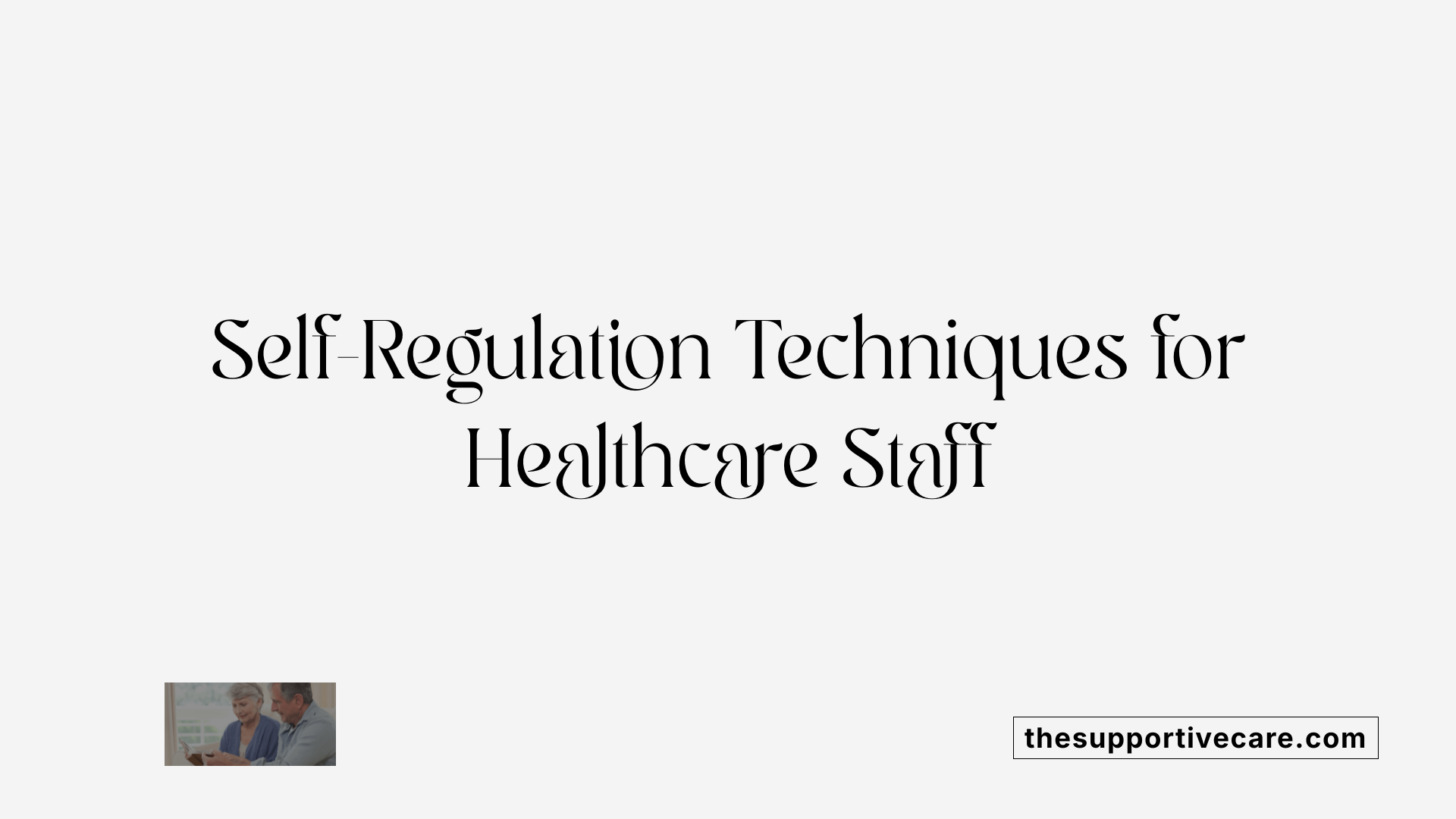
Why Is Self-Awareness Important in Emotional Self-Regulation?
Emotional self-regulation in healthcare starts with self-awareness. Providers need to understand their own feelings and reactions to manage conflicts effectively. Being aware of internal triggers and personal biases helps in maintaining calm during challenging interactions, which is crucial for conflict de-escalation.
How Do Breathing Exercises and Mindful Pauses Help?
Practical techniques such as controlled breathing and mindful pauses allow nurses to regain composure during stressful moments. These methods slow down emotional reactions, helping staff respond thoughtfully rather than react impulsively. For example, a few deep breaths can reduce tension, making it easier to communicate clearly and calmly.
What Is the Impact on Effective Conflict Resolution?
By practicing emotional self-regulation, healthcare providers improve their ability to manage aggressive or agitated behavior. Calm, collected responses reduce the likelihood of escalation and promote a safer environment for both residents and staff. This mindset supports building trust and rapport, which is essential for ongoing patient care and successful conflict management.
How Do Provider Attitudes and Beliefs Influence This Process?
A provider's attitudes and beliefs shape how they respond to challenging behaviors. Emphasizing empathy, respect, and patience fosters positive interactions. Conversely, negative assumptions can make situations worse. Training encourages self-control and reflective practice, helping providers align their actions with compassionate care principles.
Emotional regulation techniques empower healthcare professionals to handle behavioral challenges skillfully, contributing to safer, more respectful nursing facility environments.
Building a Culture of Compassionate Conflict Resolution
Effective de-escalation in memory care units is a multifaceted process that combines comprehensive staff training, awareness of behavioral triggers, cultural competence, and safety preparedness. By understanding the unique challenges posed by cognitive impairments and addiction-related mental health issues, healthcare providers can apply evidence-based strategies tailored to individual needs. Ongoing education, practical skill-building, and emotional self-regulation are critical to sustaining a harmonious and safe care environment. Ultimately, fostering empathy and respect ensures that residents receive dignified care that supports their well-being and safety.
References
- De-Escalation Strategies In-Service Toolkit
- Jessica Shook- De-escalation.pdf - DSHS
- 5 De-Escalation Techniques for Nurses and Challenging ...
- Integrated Treatment for Co-Occurring Disorders
- Integrating Treatment for Co-Occurring Mental Health ...
- Managing Life with Co-Occurring Disorders
- Alcohol & Drug Addiction Treatment for Veterans
- Treatment Types for Mental Health, Drugs and Alcohol
- Types of Drug and Alcohol Treatment Programs For Adults




































































































